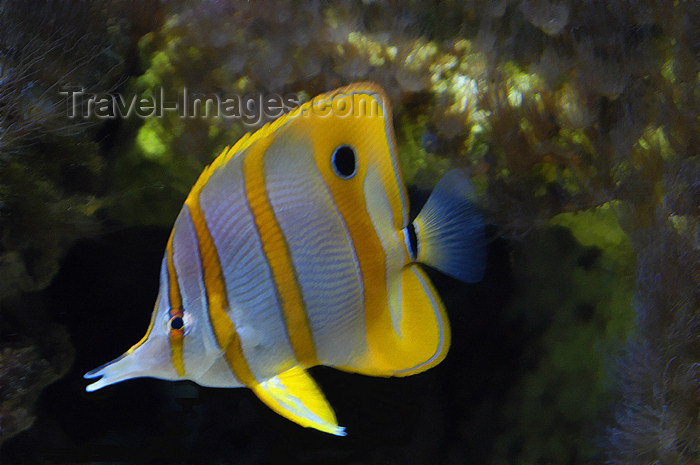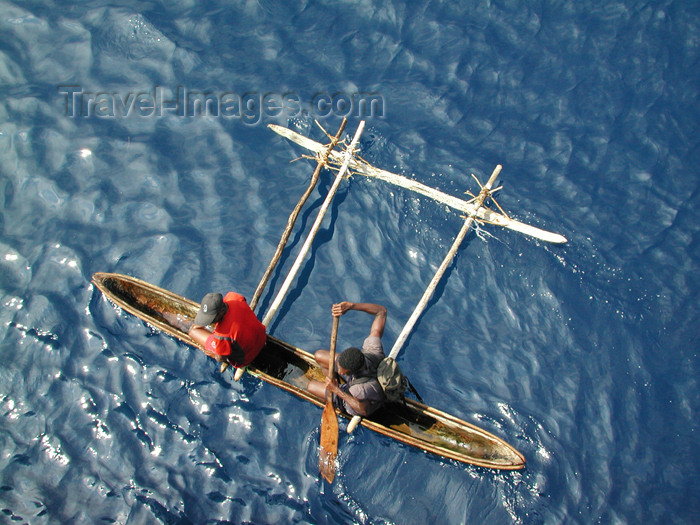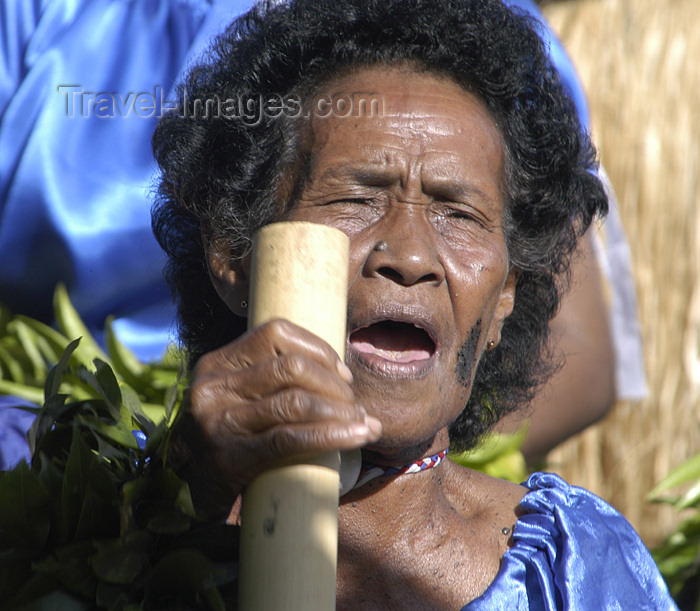 by
Bill Cain
by
Bill Cain
| Travel Articles for Publishers |
Travel-Images.com
|
Melanesia - Cultural Exchanges
in the South Seas
 by
Bill Cain
by
Bill Cain
“On Ifaluk Island the chief has outlawed two
things – outboard motors and bras.”
- World Discoverer expedition leader
Conrad Combrink at a pre-disembarkation briefing
For many, the term “South Seas” conjures up images of tiny sun drenched islands with palm fringed beaches whose primitive native inhabitants wear grass skirts, flowers in their hair and not much else.
Such places still do exist and can be visited
in relative comfort compared with the hardships endured by the likes of
Captain Cook and other 17th & 18th Century explorers who first braved
the waters in this part of the world.
One such endurance that today’s traveler isn’t inconvenienced with is the practice of cannibalism, the grisly reminder of which is still found throughout the entire South Pacific. Even though missionary zeal led to the destruction of much of the indigenous culture in the entire Melanesian region, it did manage to curb this disturbing custom. One such island grouping where cannibalism revival for the tourist trade has become popular is Fiji, where reproduction cranium clubs, throat skewers and various eating utensils are hot souvenir items. Fiji is also where I began a recent exploration of the Coral Sea area.
A remarkable expeditionary cruise ship called the World Discoverer takes small groups (80 in my case) in 1st class style and comfort on a variety of journeys as part of its year-long circumnavigation of most of the Pacific Rim from the Arctic to the Antarctic. My segment of choice was the 3-week voyage from Fiji, through Vanuatu, the islands and mainland of Papua New Guinea, several atolls in Micronesia and ending in Guam.
Life aboard the World Discoverer, when you aren’t off exploring a remote island, is more of a treat than an endurance. The ship is appointed with luxurious state rooms - some with private balconies, as well as a pool, library, and spacious dining room where gourmet fare is served each evening. On board “entertainment” is in the form of locally pertinent talks, lectures and visual presentations in the lounge by a panel of experts in the fields of anthropology, archaeology, ornithology, zoology and botany. The ship is also equipped with scuba diving facilities and trained personnel who guide certified divers to some relatively untouched coral reefs where few other ships visit.
 But
while it’s nice to be pampered while aboard the World Discoverer, the highlights
of the cruise from Fiji to Guam are focused around cultural encounters
with local people on remote islands. Fortunately, to facilitate landing
on these islands, the ship is equipped with a fleet of inflatable rubber
zodiacs – small motorboats which can zip up to 10 passengers each back
and forth to where friendly islanders wait to greet you.
But
while it’s nice to be pampered while aboard the World Discoverer, the highlights
of the cruise from Fiji to Guam are focused around cultural encounters
with local people on remote islands. Fortunately, to facilitate landing
on these islands, the ship is equipped with a fleet of inflatable rubber
zodiacs – small motorboats which can zip up to 10 passengers each back
and forth to where friendly islanders wait to greet you.
Because of the infrequency of foreigners to most of the islands visited, the arrival of the World Discoverer just off shore is a highly anticipated, major event in the lives of the locals. Imaginatively choreographed welcoming ceremonies are carefully organized by both the ship’s expeditionary officials and those of the villages. Boat loads of tourists arriving on the beach are typically met by a contingent of colorful “receptionists” who dance, chant and sing welcoming refrains in the native language. On some islands, members of musical ensembles strum guitars and bang out rhythmic beats on a variety of bongo drums. The air is sometimes raucous, but festive with mutual feelings of good will between the two different cultures. On Ali Island in Papua New Guinea, no sooner have guests hit the beach before they are “initiated” by having their cheeks smeared with a bright orange, water soluble lip stick paste. Hundreds of curious onlookers, many from the far flung outer villages on some of the larger islands, gather to gawk and stare at the funny looking foreigners with their cameras and other strange looking gadgets.
Once all the ship’s passengers are safely
ashore, the mixed throng of locals and tourists are escorted, sometimes
with more singing and dancing, on a short processional walk into the village
where the official welcoming ceremony takes place. Expedition team leaders
from the ship give short speeches expressing thanks for permission from
the local authorities to visit, as well as extolling the virtues of the
beautiful island. Local leaders, in turn, welcome the newly arrived tourists
and thank the ship’s crew for including their island in the cruise itinerary.
Then, in a unique display of appreciation, bundles of gifts from the ship’s passengers are presented by a pre selected individual who acts as the honorary ambassador. A brief statement is then given to the assembly by the ambassador expressing friendship and gratitude. I was honored to have been asked to be the official ship’s good will ambassador to Ali Island.
Because of the inevitable inequities which occur with private gift giving to the islanders, the ship’s policy is to collect all passenger gifts at the beginning of the cruise, sort and portion them by island and then dispense them anonymously through the ambassador program throughout the cruise. The only private gifts I was able to give were photos of selected islanders whose images I was able to print on a small, compact, battery-operated digital printer I carried with me. In one village I was given a couple of small handmade gifts in appreciation.
After the obligatory welcoming ceremonies are completed, the sing sing, or local entertainment/festival begins. Song and dance troupes, whose bodies are brightly painted and festooned with flowers, shells, beads and pig tusks perform tribal re-enactments dressed in a riot of outrageously colorful costumes and head gear. Several of these performances can be going on simultaneously in different areas of the village, making it difficult to know where to point your camera next. The cultural diversity of the Melanesian region is evident at these sing sings where each island displays its own unique heritage and none of the vibrant displays are the same.
 At
the conclusions of the sing sings visitors generally have the next several
hours to mingle with the villagers, shop for local handicrafts and take
informal tours of some of the dwellings to see how daily life is lived.
Despite their limited understanding of English, the local people on these
islands are incredibly friendly and eagerly embrace the opportunity to
make new acquaintances with those they know have traveled so far to visit
them. The children are particularly approachable and politely inquisitive
about anything a ship’s passenger goes out of his or her way to show them.
Not once did anyone wave away my sometimes intrusive camera. Hand shaking,
hugs, smiles and sincere expressions of good will are in abundance during
these intimate cultural exchanges.
At
the conclusions of the sing sings visitors generally have the next several
hours to mingle with the villagers, shop for local handicrafts and take
informal tours of some of the dwellings to see how daily life is lived.
Despite their limited understanding of English, the local people on these
islands are incredibly friendly and eagerly embrace the opportunity to
make new acquaintances with those they know have traveled so far to visit
them. The children are particularly approachable and politely inquisitive
about anything a ship’s passenger goes out of his or her way to show them.
Not once did anyone wave away my sometimes intrusive camera. Hand shaking,
hugs, smiles and sincere expressions of good will are in abundance during
these intimate cultural exchanges.
Back on board the ship later in the evening, a re-cap of the day’s activities is held by the expedition team, followed by a question and answer session and then a briefing about the next day’s program. Twelve such days of this unique cruise were spent interacting with indigenous peoples of the South Seas in this manner.
Society Expeditions, which owns the World
Discoverer, offers several other 2-3 week exploratory cruises in and around
the Pacific Rim including ones to the Russian Far East, remote western
Alaska, Antarctica and other parts of the South Pacific. They can be contacted
at their Seattle, WA office at 800-548-8669 or at www.societyexpeditions.com.
| see also: travel articles, images, about us, photographers |
|
|
|
|
|
|
|
|
|
|
| Travel Articles |
www.travel-images.com
|